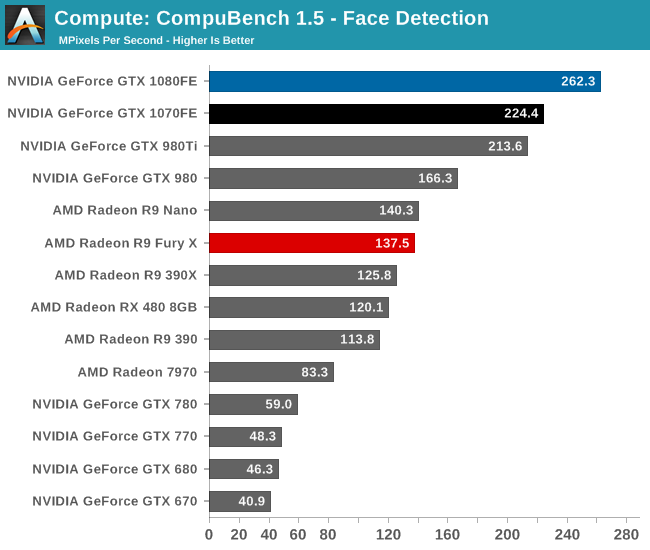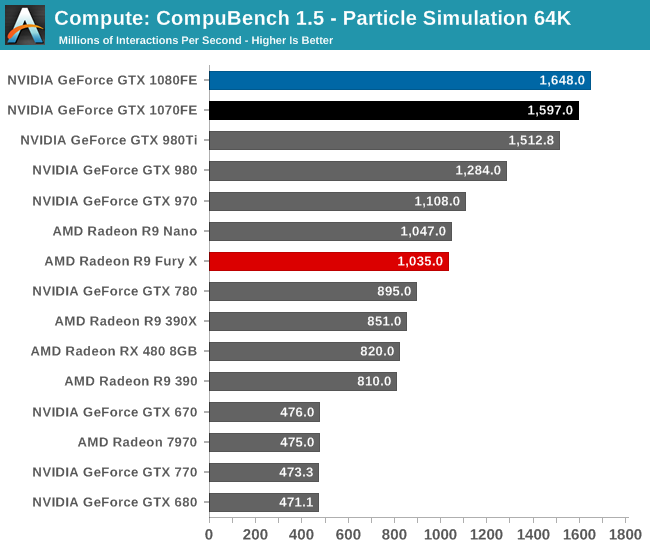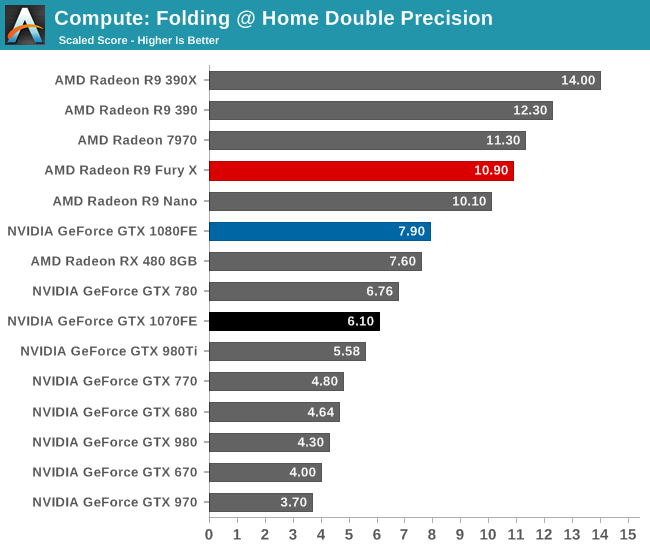The NVIDIA GeForce GTX 1080 & GTX 1070 Founders Editions Review: Kicking Off the FinFET Generation
by Ryan Smith on July 20, 2016 8:45 AM ESTCompute
Shifting gears, let’s take a look at compute performance on Pascal.
Overall, we’re not expecting a significant difference in compute performance compared to Maxwell 2 for standard compute benchmarks. The fundamental architecture hasn’t changed – the CUDA cores, register files, and caches still behave as before - so there’s little reason for compute performance to shift. GP104 for all intents and purposes should perform like a higher clocked and slightly wider Maxwell 2, similar to what we’ve seen in most games.
However in the long run there is potential for Pascal to show some improvements. The architecture’s improved scheduling features are geared in part towards HPC users, and instruction level preemption means that compute kernels can now be a lot more aggressive on consumer systems since they can be paused so easily. That said, to really leverage any of these improvements, applications utilizing GPU compute need to have work that benefits from better scheduling and be written with Pascal in mind, and for consumer workloads the latter is likely a long way off.
Starting us off for our look at compute is LuxMark3.1, the latest version of the official benchmark of LuxRender. LuxRender’s GPU-accelerated rendering mode is an OpenCL based ray tracer that forms a part of the larger LuxRender suite. Ray tracing has become a stronghold for GPUs in recent years as ray tracing maps well to GPU pipelines, allowing artists to render scenes much more quickly than with CPUs alone.

As with games, when it comes to LuxMark, the GTX 1080 is uncontested; this is the first high performance FinFET GPU in action. That said, I’m surprised by how close some of these results cluster. Though GTX 1080 is not a full generational replacement for GTX 980 Ti, normally it outperforms the Big Maxwell card by more than this. Instead we’re looking at a lead of just 10%, notably less than a simple extrapolation of CUDA core counts and frequencies would tell us to expect (GTX 1080 has almost 50% more FLOPs).
That said, GTX 1070 still places very close to GTX 980 Ti – albeit below it – so what we’re seeing isn’t just Pascal being a laggard. Especially since as a consequence of this, GTX 1080 only beats GTX 1070 by 12%. In any case, this may be a case of early drivers, particularly as OpenCL has not been an NVIDIA priority for the last couple of years. Alternatively, as strange as it may be, I’m not ready to rule out LuxMark being CPU limited. It’s something that we’ll have to keep an eye on.
For our second set of compute benchmarks we have CompuBench 1.5, the successor to CLBenchmark. CompuBench offers a wide array of different practical compute workloads, and we’ve decided to focus on face detection, optical flow modeling, and particle simulations.



Depending on which sub-test we’re looking at, CompuBench is all over the place. In Face Detection the GTX 1080 takes a commanding lead, with GTX 1070 easily slotting into second place. On the other hand we have Optical Flow, which NVIDIA cards have traditionally struggled with, where even GTX 1080 can’t unseat Radeon Fury X. Finally in the middle we have the 64K Particle Simulation, which has GTX 1080 in the lead again, but not unlike LuxMark, it also has some interesting clustering going on.
Ultimately each test stresses our GPU collection in different ways, which as we can see greatly influences how the results pan out. Face Detection has always played well to NVIDIA’s strengths, and on a generational basis we get solid scaling from Maxwell 2 to Pascal. Even Optical Flow, which seems to favor raw FLOPs more than anything else, still shows very good gains with Pascal.
Particle Simulation is the outlier in this regard; Pascal’s generational gains are not insignificant, but they’re less than what we’d expect. Furthermore GTX 1080 and GTX 1070 are very closely clustered together despite their much larger difference in FLOPs. This may mean we’re looking at a CPU or driver bottleneck, or possibly some sort of internal path bottleneck. GTX 1080 has more FLOPs and a similar advantage in memory bandwidth, but once you get on chip things get much closer. If nothing else this goes to show that compute benchmarks are much more architecture sensitive than games, which is why we can’t make very broad generalizations for all compute workloads.
Moving on, our 3rd compute benchmark is the next generation release of FAHBench, the official Folding @ Home benchmark. Folding @ Home is the popular Stanford-backed research and distributed computing initiative that has work distributed to millions of volunteer computers over the internet, each of which is responsible for a tiny slice of a protein folding simulation. FAHBench can test both single precision and double precision floating point performance, with single precision being the most useful metric for most consumer cards due to their low double precision performance. Each precision has two modes, explicit and implicit, the difference being whether water atoms are included in the simulation, which adds quite a bit of work and overhead. This is another OpenCL test, utilizing the OpenCL path for FAHCore 21.


In single precision performance, to the surprise of no one the GTX 1080 is solidly in the lead, followed up by the GTX 1070. On a generational basis performance gains are decent, but at 44% for GTX 1080 they aren’t quite as great as we’ve seen from the card elsewhere. Meanwhile the two Pascal cards are again closer than we’d expect, with GTX 1080 leading by only 10%.
As for double precision performance, we can see that even with the higher overall compute throughput of GP104, it still can’t make up for the fact that FP64 performance on the GPU is capped at 1/32 by virtue of so few FP64 CUDA cores, which puts even NVIDIA’s latest and greatest at a disadvantage here. But if nothing else, generational scaling versus Maxwell 2 looks very good, with performance gains closely tracking the theoretical increase in FLOPs.










200 Comments
View All Comments
Matt Doyle - Wednesday, July 20, 2016 - link
Same page, "The latter is also a change from GTX 980, as NVIDIA has done from a digital + analog DVI port to a pure digital DVI port.""NVIDIA has gone"?
Matt Doyle - Wednesday, July 20, 2016 - link
Rather, "Meet the GTX 1080" page, second to last paragraph.Matt Doyle - Wednesday, July 20, 2016 - link
"Meet the GTX 1080..." page, "...demand first slow down to a point where board partners can make some informed decisions about what cards to produce."I believe you're missing the word "must" (or alternatively, "needs to") between "demand" and "first" in this sentence.
Ryan Smith - Wednesday, July 20, 2016 - link
Thanks!supdawgwtfd - Wednesday, July 20, 2016 - link
Didn't even finish reading the first page. The bias is overwhelming... So much emotional language...Good bye Anandtech. Had been a nice 14 years of reading but it's obvious now you have moved to so many other sites.
Shills who can't restrain their bias and review something without the love of a brand springing forth like a fountain.
Yes i created an account just for this soul reason...
The fucking 2 month wait is also not on.
But what to expect form children,
BMNify - Wednesday, July 20, 2016 - link
Then just GTFO you idiot, on second thoughts crying your heart out may also help in this fanboy mental break down situation of yours.catavalon21 - Wednesday, July 20, 2016 - link
You're joking, or a troll, or a clown. I complained about the time it took to get the full article, (to Ryan's credit, for the impatient ones of us just looking for numbers, he noted a while back that GPU bench was updated to include benchmarks for these cards), but this is exactly the kind of review that often has separated AT from numerous other sites. The description of the relatively crummy FP16 performance was solid and on point. From NV themselves teasing us with ads that half precision would rock our world, well, this review covers in great detail the reset of the story.Yeah, I know guys, I shouldn't dignify it with a response.
atlantico - Thursday, July 21, 2016 - link
Anandtech have always been nvidia shills. Sad they can't make a living without getting paid by nvidia, but they're not alone. Arstechnica is even worse and Tomshardware is way worse.brookheather - Wednesday, July 20, 2016 - link
Typo page 12 - "not unlike AMD’s Pascal architecture" - think you mean Polaris?brookheather - Wednesday, July 20, 2016 - link
And another one on the last page: it keep the GPU industry - should be kept.